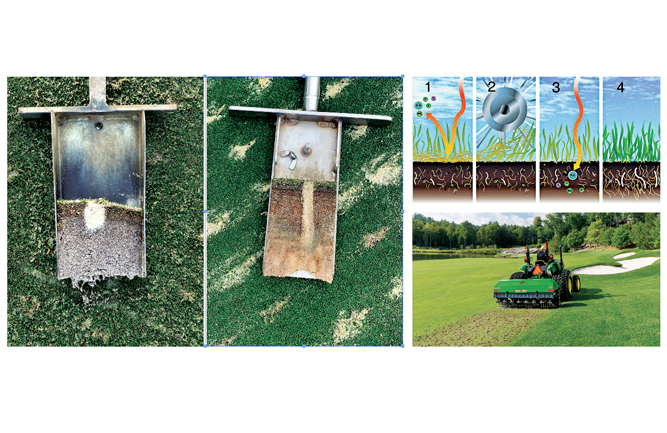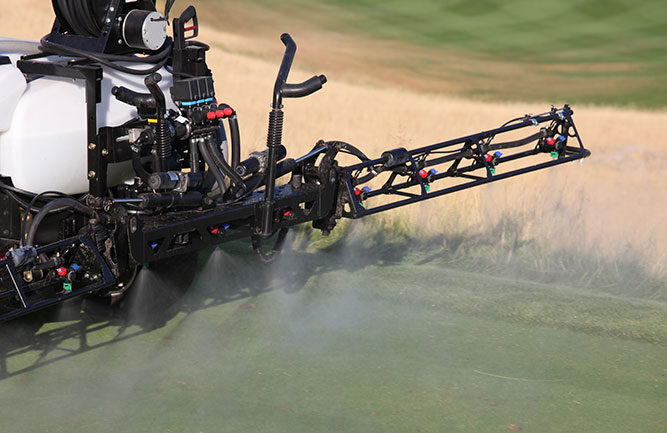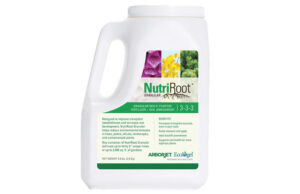Experts share tips to detatch your thatch

Turf before and after dethatching shown (left). Superintendents use verticutting to dethatch the turf and help encourage the natural exchange of nutrients from the atmosphere and the soil. (Photos: Bluebird Turf / Dryject / John Deere)
According to Doug Soldat, Ph.D., professor in the department of soil science at the University of Wisconsin-Madison, there is nothing wrong with having some thatch on your golf course. In fact, a small amount is normal.
However, if your course has excessive thatch growth, it’s likely that something is out of balance. It may be growing rapidly, due to excess fertilization. Or it might be decomposing too slowly, as a result of an acidic soil environment.
Whatever the cause, superintendents can successfully contend with thatch by reducing their fertilization amounts; liming, which increases pH and in turn, leads to microbial breakdown; and managing their thatch layers with more aggressive cultivation and topdressing practices.
“Superintendents must remove excess thatch as quickly as they can, or else it will bind pesticides that are intended for the root zone,” Soldat says. “Once this occurs, surfaces will become soft and spongy, while rooting will become shallow, among other problems.”
As superintendents prepare to contend with excess thatch, they must also remember that thatch accumulation occurs on a seasonal cycle. It always accumulates the fastest during times of active growth (during the spring and fall for cool-season grasses). And it decomposes the fastest during the summer.
Thatch can also occur with any type of growth habit. However, it is much more severe in grasses that have stoloniferous growth habits, as stoloniferous grasses produce a lot of biomass above soil surfaces.
“These grasses include most of the warm-season grasses, along with creeping bentgrass,” he adds. “Areas with short, cool growing seasons are prone to thatch accumulation though, as thatch breaks down faster in warm temperatures.”
While focusing on these growth and accumulation trends, superintendents should consider utilizing certain enzymes, such as laccase, along with products (like molasses) that stimulate microbial activity and, consequently, reduce thatch.
Although these enzymes and products are certainly worth investigating, Soldat believes superintendents must not forget about the “big picture” drivers behind their thatch accumulation.
“Is the fertility rate too high? Is the pH too low? Should the topdressing and cultivation program be more aggressive?” He asks. “Chemicals should be secondary to good cultural practices. Focus on enhancing your cultural practices — and your excess thatch will be removed.”

Chris Durig
Bluebird Turf
Chris Durig
Vice president, sales and marketing
Healthy turf requires adequate water, an exchange of oxygen and nutrients, and a level of microbial activity in its soil. A thatch layer (an accumulation of roots, crowns and grass clippings that creates a dense mat of vegetation at the soil level) acts as an insulator, as it keeps soil temperatures low and helps retain moisture. However, when thatch build-up becomes excessive, it can prevent the exchange of water and vital nutrients from the atmosphere to the soil, thereby decreasing the turf’s ability to thrive and fight disease and dehydration.
Dethatching, also known as combing or power raking, is a process that removes unwanted thatch. It’s recommended to dethatch twice a year — once as the grass just begins its growing season, and again just before it enters dormancy, in order to provide turf a better chance of recovery after combing. It’s also important to ensure the blades of your comber are not set too deeply.

Brad Aldridge
John Deere
Brad Aldridge
Product manager, Golf reel and rotary mowers
The best way to contend with thatch on a golf course is to perform frequent, light topdressing. Many courses are now performing topdressing once a week to incorporate sand into the canopy a little at a time, while additional brushing helps work it into the course. Regular grooming with a fairway tender conditioner or greens tender conditioner to slice rhizomes and stolons also helps promote new vertical growth (and less lateral growth).
To be more aggressive with slicing rhizomes and stolons, I also recommend regular verticutting. With today’s verticutters, you won’t see the lines right after you mowed, so playability is really high. Depending on grass type, you may need to consider catching grass on fairways to prevent thatch. While not performed as often as topdressing and verticutting, aeration is always an important practice to keep thatch off the golf course too. Finally, scalping — when transitioning out of dormancy and collecting the material — can help reduce thatch build-up as well.

John Paddock
DryJect
John Paddock
Owner and president
The rate at which thatch accumulates in turf is highly influenced by the inputs of the superintendent. Careful attention should be given to only apply enough fertility and water to produce a uniform, healthy playing surface. Excess inputs will magnify thatch accumulation.
Thatch levels can be manipulated by encouraging healthy biological activity (decay) through the incorporation of the native soil back into the top portion of the thatch, via core aeration and dragging. Topdressing or injection with either a blended soil/sand mix or sand alone are other options superintendents should consider.
By incorporating these materials, superintendents can create a “hybrid thatch” or mat, which firms it up and encourages robust microbial activity and decay. Regular incorporation of the desired soil medium will provide the necessary dilution to this organic matter. On sand-based putting greens or sports turf, the injected or topdressed sand should be close to matching the sand in the soil profile.

Marinus Reincke
Maredo B.V.
Marinus Reincke
CEO
Typically, thatch is removed by using a verticutter, which cuts a continuous slit in the ground that takes a long time to heal. Not to mention, verticutter blades don’t cut thatch and turf nicely, as damage to healthy turf leads to a longer recovery — even if topdressing is applied.
However, if superintendents use lightweight triplex greens mowers and attach GT230 HiSpeed-Coring heads to them, they will pull approximately 4 million cores per hour. Eighteen average-sized greens take about four to five hours to core. In addition, since the heads only pull thatch plugs, they can be easily blown off the green.
By utilizing these heads, superintendents can also transform their triplex greens mowers into innovative high-speed greens corers, which can reach a maximum depth of one inch. And since they use 0.25-inch (ID) hollow tines, along with micro hollows, solids and slicer tines, the GT230 HiSpeed-Coring heads offer superintendents an alternative to verticutting — one that doesn’t damage healthy turf, thus minimizing recovery considerably.












